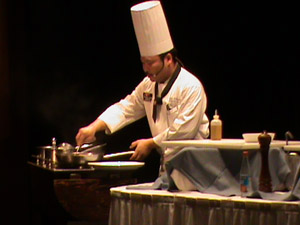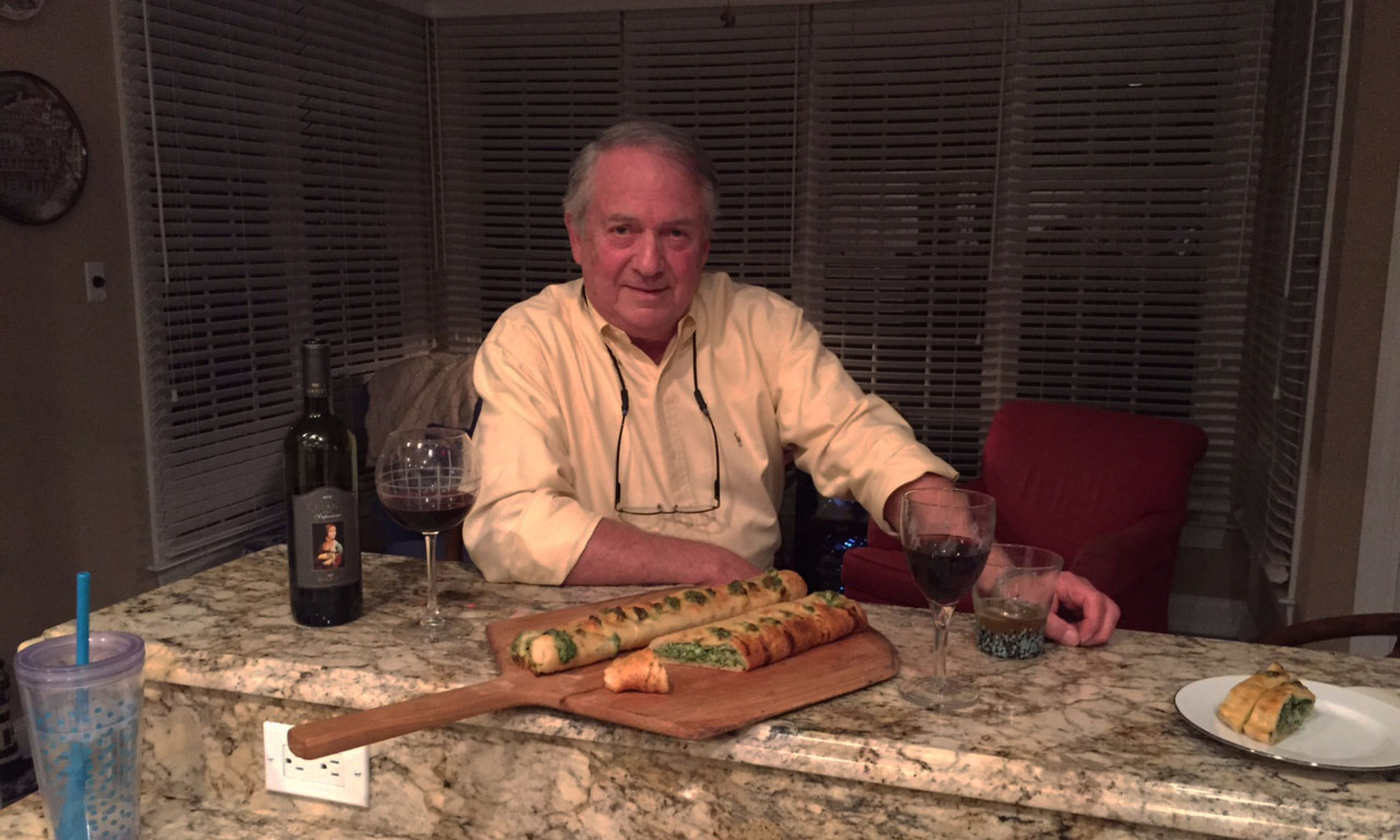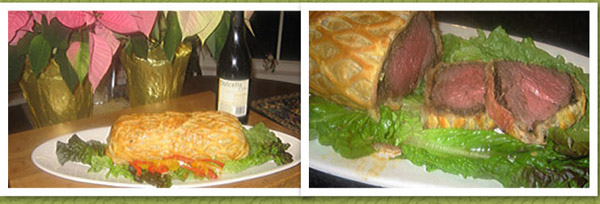QM2 is shorthand for the Cunard liner Queen Mary, Second Iteration, i.e. a remake of the original HMS Queen Mary now resting comfortably in mothballs, disguised as a hotel, in Long Beach California. Being relatively new to big time cruising I never fail to be impressed by the enormity of the tasks associated with moving an object the size of the Empire State Building around the ocean, not to mention the scope of effort required to feed 2500 of your closest friends three times a day.
 This most recent cruise took us around the Caribbean to ports that I had not previously visited – St. Thomas, St. Lucia, Grenada and a few others. It was an 11-day extravaganza with four of the 11 nights requiring me to squeeze into a tux that I bought when I was 20 pounds lighter. What prompts me to write about it however is not the locations we visited, all of which resemble one another and do not require a re-visit any time soon, but the outstanding performance by the catering and restaurant staff who managed to turn out culinary masterpieces at every meal.
This most recent cruise took us around the Caribbean to ports that I had not previously visited – St. Thomas, St. Lucia, Grenada and a few others. It was an 11-day extravaganza with four of the 11 nights requiring me to squeeze into a tux that I bought when I was 20 pounds lighter. What prompts me to write about it however is not the locations we visited, all of which resemble one another and do not require a re-visit any time soon, but the outstanding performance by the catering and restaurant staff who managed to turn out culinary masterpieces at every meal.
The caveat is that these comments apply to the principal and very elegant main dining room on board, not the cafeteria or any of the other premium priced dining venues. The cafeteria attempts to recreate four different styles of cuisine at four different stations and is definitely still a work in progress. We learned early on to skip it except for coffee and afternoon snacks. The main Britannia Dining Room is the place to be and I could have set up a cot inside and spent the whole trip in it.
Now I know people will accuse me of being judgmental when I say this, but the only deficiency on the part of the kitchen became evident whenever it offered up dishes that purported to embrace an Italian character. Throughout the cruise I made a point to select as many of the Italian-inspired items as I could, so I feel confident in alleging that it is not just a one dish issue but a consistent failure. And so I stated on the comment card upon disembarking, which I’m sure has long since tossed overboard.
I should also mention as long as criticisms are in order that one of the upscale premium restaurants on board, for which a surcharge is required to gain access, was a huge disappointment. It was the “Todd English” supposedly overseen and godfathered by the otherwise extremely well-known and well-regarded cooking celebrity of the same name. My guess is that Todd shows up on board once every 2 or 3 years to check out the menu and the recipes. Otherwise, in his absence quality control and execution are just concepts, not a reality. My travel buddy ordered a chicken dish that was assassinated by the addition of an excessive quantity of Pernod liqueur. I forgot what I ordered which is a statement all in itself. No need to visit that establishment again. Head for the Casino instead.
Having said all that I go on to claim that everything else turned out by the kitchen, I should say the galley -predominantly French-inspired, British, and more or less international selections – all merited 4 stars in my book, having no idea what Gordon Ramsey would say about it if he were doing the tasting. Fortunately at the end of the cruise the wait staff presented me with a collection of all the Britannia Room menus and I now have them preserved in a safe place.
 Along the way I attended a cooking demonstration conducted by one of Executive Chef Jean-Marie Zimmermann’s sous chefs, who turned out a magnificent-looking Beef Wellington ready for the oven in about 50 minutes time. I have spun out maybe 10 or 12 Wellingtons in my day but never in less than 3 hours, mainly because it is necessary to trim out the tenderloin before setting up the recipe, and that takes me forever. I’m sure the chef did that ahead of time. Anyway on returning home I set out to execute the QM2 recipe to see whether the taste matches up with the eye-catching item created by the chef before an audience of about 200 people. The notable feature incorporated by the QM2 chef was the placement of a thin crepe on the puff pastry before wrapping the meat so that the juices would not turn the puff pastry into a soggy mess. I have since learned that this is a common technique.
Along the way I attended a cooking demonstration conducted by one of Executive Chef Jean-Marie Zimmermann’s sous chefs, who turned out a magnificent-looking Beef Wellington ready for the oven in about 50 minutes time. I have spun out maybe 10 or 12 Wellingtons in my day but never in less than 3 hours, mainly because it is necessary to trim out the tenderloin before setting up the recipe, and that takes me forever. I’m sure the chef did that ahead of time. Anyway on returning home I set out to execute the QM2 recipe to see whether the taste matches up with the eye-catching item created by the chef before an audience of about 200 people. The notable feature incorporated by the QM2 chef was the placement of a thin crepe on the puff pastry before wrapping the meat so that the juices would not turn the puff pastry into a soggy mess. I have since learned that this is a common technique.
Warning: to replicate the QM2 production you will need one of those lattice cutters that are used to create a lattice effect on pie crusts and other pastries. I have one. You can skip it if you want but the visual effect is very impressive if you decide to go to the trouble.
The recipe – which is actually quite standard when all is said and done – works just fine, so here it is:
The QM2 Wellington
For 4-6 persons (are you ready for this?):
-
1 three pound whole tenderloin strip trimmed and tied with kitchen twine to keep its shape
-
2 tbsp. butter
-
1 shallot finely chopped
-
4 oz. mushrooms finely chopped (pretty much any kind will do. I use dried porcini reconstituted but make sure to remove all the sand. Repeated dousing in hot water and draining will do the trick. Otherwise use cremini from the store and save a ton of effort)
-
1 four oz. can liver pate’ (this is not part of the QM2 recipe but I highly recommend including it)
-
3 tbsp. chopped fresh flat leaf parsley
-
1 package frozen puff pastry thawed (despite the claims this product is not all that user-friendly!)
-
1 large egg beaten for glaze
-
2 tbsp. flour or more as needed
-
2 tbsp. olive oil
-
2 cups chicken or beef stock
-
1/2 cup red wine
-
3 tbsp. Dijon mustard
-
1 thin crepe or large flour tortilla (I understand the reason for it but am not totally convinced of the necessity)
-
salt & pepper to taste
Preheat oven to 400 degrees. Sprinkle salt and freshly ground black pepper all over the tenderloin. Heat olive oil in a large-diameter oven-safe saute’ pan and sear the tenderloin until well browned on all sides, about 10 minutes. Transfer to the oven and roast for about 25 minutes or until meat thermometer registers 140 degrees (medium rare).
Heat butter in saute’ pan and cook shallots and mushrooms until completely softened. Add parsley, salt and pepper, and blend in the liver pate’. Set aside. This is the mushroom “duxelle.” Remove tenderloin from oven when done and allow to cool. Save the juices. Remove the string. Then spread the Dijon mustard all around. Set aside. Meanwhile roll out 2 sheets of the puff pastry on a floured board. This is the hard part so pour a glass of Dolcetto d’Alba for fortification. It’s for you, not the Wellington. Better to roll out too much puff pastry than too little but the sheets should be no less than half the thickness as the original package size. You need about an 18 x24 inch square for wrapping depending on the size of the tenderloin. You can piece together strips of the dough to get to the right size but that’s a tough assignment. One sheet, the 18 x20, is for wrapping the tenderloin and the other is for the lattice decoration.
Place the crepe or tortilla on top of the 18×20 pastry dough. Spread the mushroom/pate’ mix all around. Lay the cooked tenderloin on top, dress it with more duxelle then wrap it with the dough starting with the left and right sides, bring them up and over then bringing the long edges up and over. Press the seams firmly then roll the tenderloin over so that the seams are on the bottom. I know this is not for the faint-hearted but press on! Brush the wrapping with egg wash.
For the lattice decoration run a lattice cutter over the second sheet. Place the sheet over the wrapped tenderloin and tuck the sides and ends in snugly. Trim off any excess. Brush all over with more egg wash. Using two big spatulas carefully transfer the tenderloin onto a sheet pan, not a high-sided roasting pan. The idea is to facilitate removal to the final presentation platter without damage. Cook in the oven at 400 degrees for about 20-25 minutes or until pastry crust turned golden brown. You’re done. You made it to the finish line!
For a sauce heat up the reserved meat juices, stir in 2 tbsp. flour add the stock, wine (if there’s any Dolcetto left use it) and reduce until slightly thickened. I add a tablespoon of chopped fresh rosemary.
For serving place the tenderloin onto a flat serving platter and cut portions with a serrated knife slowly and carefully to avoid disturbing the pastry crust.
Note: In case you’re wondering what has to happen before you have a whole tenderloin ready for setting up as a Wellington, take a look. The first thing to notice is that the meat you took home from the store is shaped like a giant tadpole and needs a lot of work:
Not an easy project. On the left is the undressed tenderloin. If you don’t ask the butcher to trim it up you have to do it yourself. On the top right is a trimmed tenderloin with the “Chateaubriand” head trimmed away, fat and all sorts of silver skin removed. Notice I use a fish fillet knife to do all the surgery. Then, at the lower right, the final prepped item is tied and ready for browning and roasting. Definitely not a candidate for Thirty-Minute Meals. But if you get it right the effect on your dinner guests will be incalculable!
Here is the final outcome:


